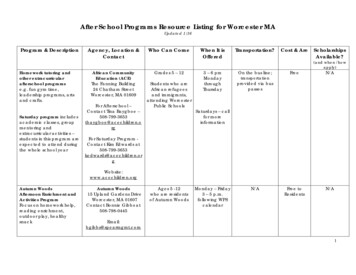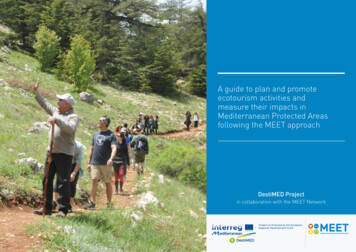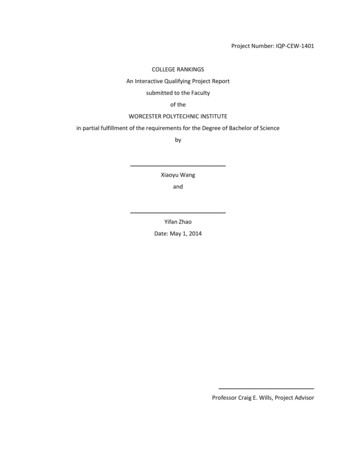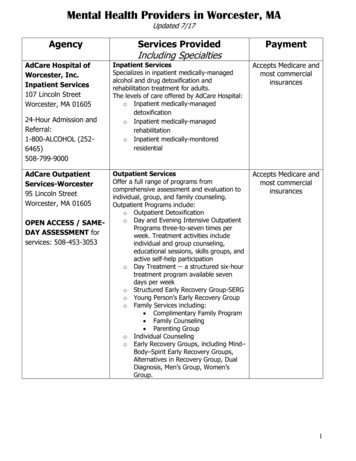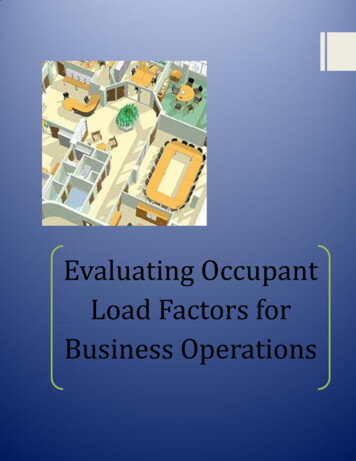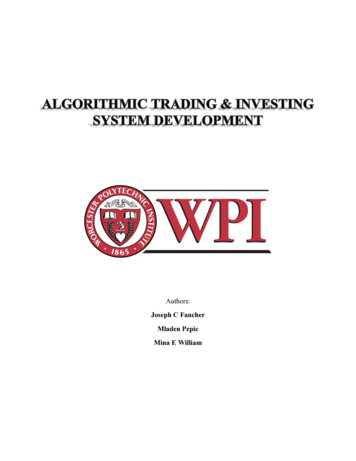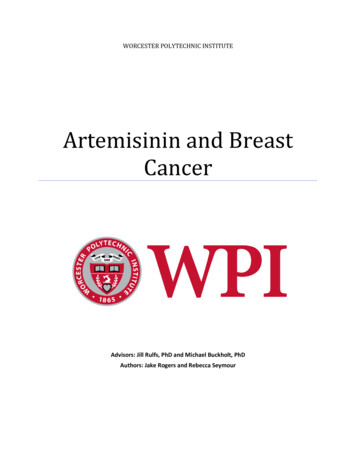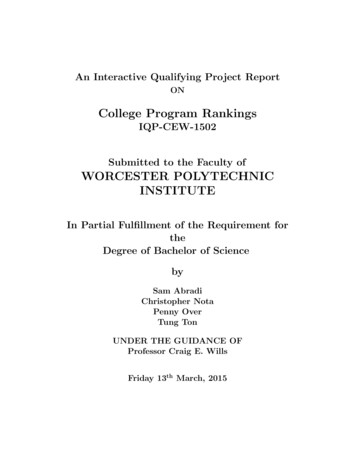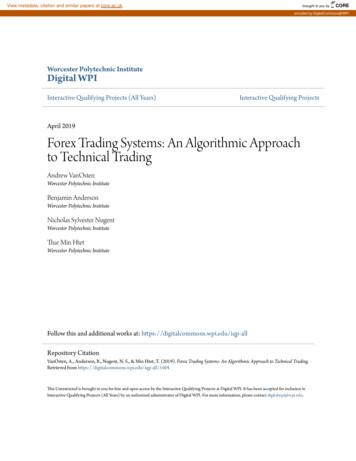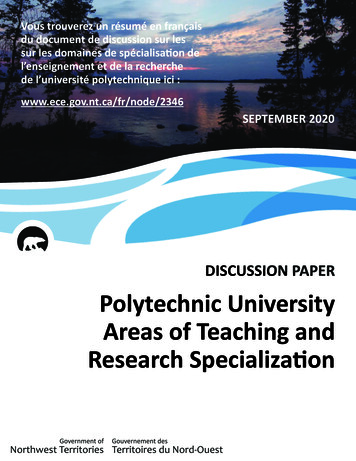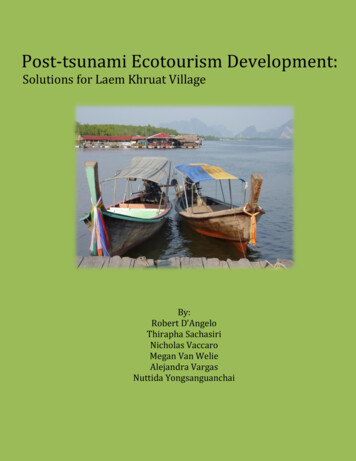
Transcription
Post-tsunami Ecotourism Development:Solutions for Laem Khruat VillageBy:Robert D’AngeloThirapha SachasiriNicholas VaccaroMegan Van WelieAlejandra VargasNuttida Yongsanguanchai
Post-tsunami Ecotourism Development:Solutions for the Laem Khruat VillageAn Interactive Qualifying Project and Social and Science Project submitted to Faculty ofChulalongkorn University and Worcester Polytechnic InstituteIn Partial Fulfillment of the Requirements for the Degree of Bachelor of Science by:Robert D’AngeloThirapha SachasiriNicholas VaccaroMegan Van WelieAlejandra VargasNuttida YongsanguanchaiDate: March 4, 2010Report Submitted To:Thomas RobertsonBrigitte ServatiusSupawan TantayanonThis report represents the work of four WPI and two Chulalongkorn University undergraduatestudents submitted to the faculty as evidence of completion of a degree requirement. WPIroutinely publishes these reports on its web site without editorial or peer review.
ABSTRACTThis report assesses the tourism industry in Laem Khruat, a rural village in the Krabi Province ofThailand that was affected by the 2004 tsunami. We investigated methods of incorporating theprinciples of ecotourism into the village’s tourism practices. We concentrated on three issues affectingthe village: waste disposal, tourism marketing, and water based tourism transportation. We concludedthat an expanded garbage bank program, new brochures and a website are necessary for furtherecotourism development. We also concluded that a kayak with a Mirage drive pedal system is effectivefor ecotourism.i
ACKNOWLEDGEMENTSThis project could not have been accomplished without the help, advice, and guidance from oursponsors, our professors, the Laem Khruat Village officials, Worcester Polytechnic Institute,Chulalongkorn University, our friends and our families.We would like to express gratitude to our sponsor, the Population and Community DevelopmentAssociation (PDA), for giving us the opportunity to contribute to Laem Khruat and the communities ofrural Krabi. We would like to thank Mr. Wirat, the Director of PDA office Bangkok for familiarizing andintroducing us to the work of the PDA. We also appreciate the outstanding efforts of Miss Sheila, whohelped us become acquainted with the villages supported by the PDA. Furthermore, we are exceedinglygrateful to Mr. Wasant, Mr. Amnuay and Mrs. Nittaya—the co-directors of PDA’s Krabi CommunityBased Integrated Rural Development (CBIRD) center—for welcoming us with such warmth and providingus with the necessary resources for our success, related or unrelated to the project. We also appreciateMr. Theng’s and Mr. Chesada, the PDA’s office personnel for driving us to each village as well asproviding us with vital information about the villages on site.We would also like to thank our advisors: Professor Thomas Robertson, Professor SupawanTantayanon, and Professor Brigitte Servatius. Their advice and feedback throughout the project andproposal periods have driven the project in a direction that allowed us to gain the most from thislearning experience. We especially appreciate the dedication of Professor Servatius, who stayedovernight at three village home-stays and provided us with insightful observations that inspired severalof our final recommendations, particularly our focus on plastic waste.We would like to thank the Village Official of Laem Khruat, Mrs. Sine, for providing detailedinformation about the village needed to complete the project. We express gratitude towards Mr.NikornSarakam, the head of the tourism practices in Kok Krai village, for giving us information about thevillage’s current practices.We would like to thank Chulalongkorn University for providing us with the necessary facilities.We would like to thank Worcester Polytechnic Institute for initiating and facilitating this IQP Program.Furthermore, we would like to acknowledge the remarkable success of combining the IQP and SSPprojects into an unforgettable cross-cultural experience.We also appreciate the critiques of Professor Dominic Golding. His feedback helped us tounderstand the research process and the proper way to prepare the final report. Also, the help of MissChristine Drew allowed us to find the necessary literature, which was the foundation for our final report.ii
EXECUTIVE SUMMARYThe 2004 tsunami devastated the livelihoods of many rural, fishing villages on the western coastof Thailand. Along the western coast the tsunami destroyed approximately 5,400 fishing boats andcaused an estimated 32.7 million dollars in damage to the village fish farms (Food and AgricultureOrganization of the United Nations, n.d.). Some of these villages have since turned to tourism tocompensate for their lost income.Laem Khruat is one of these villages in the Krabi Province attempting to expand its tourismindustry to supplement income from its damaged fishing industry. The village, which is ninety percentThai Muslim, offers home-stays to promote cultural exchange. Also, Laem Khruat is surrounded bymangrove forests, which have many natural resources but are endangered worldwide. The villagers taketourists on boat tours to the mangroves and to nearby islands to showcase the area’s natural beauty.Our project sponsor, the Population and Community Development Association, is assisting Laem Khruatin preserving its culture and sensitive environment throughout the expansion of tourism in the village.PROJECT GOALS AND OBJECTIVESThis project provided suggestions to Laem Khruat, a tsunami affected village in the Krabi province ofThailand, for rural tourism that relies on community participation and control, is environmentallyfriendly, and generates income to support the village. We pursued three objectives:1. Characterize the interests and perceptions of Laem Khruat villagers regarding the tourismindustry in their village and their environmental concerns relevant to tourism.2. Conduct a needs-assessment on the current and potential tourism problems of Laem Khruat, inparticular water based tourism transportation, coastline waste disposal, and rural tourism marketing.3. Research and evaluate appropriate solutions to these current and future problems.OUR METHODS OF OBTAINING INFORMATION IN A THAI MUSLIM CULTUREWe gained our information from interviews, surveys, academic journals, the World Wide Web,and observations in villages along the western coast of Southern Thailand. We interviewed villageofficials and home-stay and tour operators in Laem Khruat and Kok Krai—a village with an establishedtourism industry in a neighboring province, Phang Nga —for information about the current state of theirtourism industry, water based tourism transportation, waste disposal system and marketing strategies.Kok Krai’s effective techniques were used as a basis for many of our suggestions. We conducted threeiii
surveys in Laem Khruat to gauge community awareness of the issues in question and to ensure that oursuggestions for development were guided by the views of the villagers. We based our approach and oursuggestions on the results of case studies found in academic journals. Also, we made use of the Internetfor gauging costs, for contacting businesses such as the Hobie Cat Company for information on theirproducts, and for exploring existing ideas from the online community.Additionally, we gathered information from villages associated with the PDA. When we visitedKok Krai, four of our group members took a kayak tour through mangroves to formulate specificationsfor a boat to operate in these forests. In the Hin Lom and Nong Talay villages of the Krabi and Phang Ngaprovinces, we collected information about the PDA’s Trash Bank, an effective recycling system thatcreates a monetary incentive for villagers to participate in the program. By interviewing villagers andobserving the communities, we inferred criteria for the ongoing success of the system and gaps in itseffectiveness.Our research was primarily limited by time constraints and the availability of villagers to takesurveys, respond to interviews and lead tours.OUR FINDINGS ON LAEM KHRUAT’S CURRENT TOURISM INDUSTRY AND OURRECOMMENDATIONS FOR IMPROVEMENTEcotourism is a form of natural resource-based tourism that is educational, low-impact, nonconsumptive, and locally oriented: local people must control the industry and receive the bulk of thebenefits to ensure sustainable development. Although Laem Khruat has an established tourism industry,the village does not fully meet the standards of a destination for ecotourism. We have compiledrecommendations for an eco-friendly, community-run and locally sustainable expansion of LaemKhruat’s tourism industry. We have restricted our recommendations to these categories mentionedabove: water based tourism transportation, waste disposal in Laem Khruat and Laem Khruat’s marketingstrategies.WATER BASED TOURISM TRANSPORTATIONFor a human-powered boat to operate properly in Laem Khruat’s mangroves, the boat mustmaintain stability in the water, function in both deep and shallow water, be resilient to damage,transportable on land, and be “one person” thick. For Laem Khruat’s tours we found that punt boats,gondolas, portable outboard electric motors on kayaks, and pedal-driven propeller kayaks areimpractical. However, the currently used Tri-yak kayak and a kayak with a Mirage drive propulsioniv
system are viable options. The Mirage drive propels a kayak hull forward using oscillating flippers, whichmodel the motion of fish fins. The oscillatory motion allows the boat to be propelled in extremelyshallow water, and the flexibility of the fins prevents damages from obstacles in the mangroves. Werecommend that if funds are allocated for expanding ecotourism, the village should construct kayakswith a Mirage drive system because it will reduce the use of longtail boats and make the mangrove toursmore accessible. The Mirage drive can be purchased individually and installed in a kayak hull that can beobtained in a neighboring province of Krabi.WASTE DISPOSAL IN LAEM KHRUATAccording to villagers, the unreliability of Laem Khruat’s current weekly government trashcollection damages the health and environment of the village. To alleviate these concerns, the villagersare willing to contribute to an improved system. We have found that the Trash Bank systemsimplemented in Hin Lom Village and Nong Talay Elementary School are successful because they are runby an organized group and are structured around three principles: education, incentive andempowerment. However, these Trash Bank systems are incomplete because they do not incorporateplastic bags, an abundant form of solid waste in Laem Khruat, as part of the recycling process. Werecommend that Laem Khruat implements a waste disposal system similar to the Trash Banks in Hin LomVillage and Nong Talay Elementary School but adds a method of recycling and of reducing the use ofsingle-use plastic bags and an education program to increase environmental awareness in the village.This method involves creating reusable bags from the plastic bags. Vendors should charge for single-useplastic bags to encourage villagers to purchase the reusable bags to ultimately eliminate single-use bags.LAEM KHRUAT’S MARKETING STRATEGIESLaem Khruat’s current marketing strategies are ineffective due to their reliance onunprofessional brochures and business cards that have errors, which prevent tourists from contactingthe village. Kok Krai, however, employs effective marketing techniques—including distributingbrochures and business cards, forming business relationships with local tourist agencies, posting theirtour and home-stay information online and attending tourism conventions. We recommend that LaemKhruat uses these techniques as a marketing model. In addition, we recommend that Laem Khruatprovides incentive for tourist agencies and hotels to promote the village, posts information on blogs,creates and maintains a website, sells handicrafts to fair trade companies, creates and distributes apostcard, and forms a coalition with nearby villages.v
CONCLUSIONThe 2004 tsunami placed hundreds of Andaman coast villages in similar economic situations tothat of Laem Khruat. While our research and evaluations were performed for Laem Khruat specifically,our final recommendations can be modified to apply to any village on the Andaman coastline trying tobecome a destination for ecotourism to compensate for income lost from the tsunami.vi
CONTRIBUTIONSROBERT D’ANGELORobert led the research of alternative boat options. He wrote the background, findings, andrecommendation sections for the human powered boat. He helped with the editing of thebackground and helped to design the structure of the background. He worked on developing theinterviews for the human powered boats and went on the mangrove tour to characterize the tour.He also helped to write the introduction and organize the logical flow of the final report. He alsoreviewed each section for grammar and style.THIRAPHA SACHASIRIThirapha was one of the main contacts between our sponsor, the PDA, and our group. Sheled most of the interviews and surveys and facilitated all communication with the rural villagers.She also worked on the marketing findings and recommendations and helped to develop the modelbrochure. She helped transcribe the interviews and helped to make the final model of a reusablebag. She helped edit the methodology. She organized Laem Khruat to have a booth at the Thai craftsfair in Bangkok. She helped post information about Laem Khruat’s tourist activity on threewebsites. She contacted individuals and agencies in Thailand to collect much of the statistics anddetails for our final report. She helped to make the final poster.ALEJANDRA VARGASAlejandra developed and wrote the waste disposal recommendations as well as thebackground sections on tourism in Thailand and ecotourism. She helped to develop the method forimproving the garbage bank program. She wrote the executive summary and helped to edit manyportions of the report. She developed the interviews and surveys for the waste disposal section. Shehelped write the manual for constructing reusable bags from single-use bags. She was in charge ofcompiling the references.MEGAN VAN WELIEMegan helped write the manual for constructing reusable bags. She also developed themethod for reproducing them. She also wrote the waste background and findings. She edited themarketing findings and recommendations and wrote the methodology. She developed theinterviews and surveys for the waste disposal section. She helped write the introduction andorganize the logic flow of the final report. She also reviewed each section for grammar and style.vii
NICHOLAS VACCARONicholas assisted with the development of the human powered boat findings andrecommendations and edited these sections. He also wrote the marketing background and editedmany portions of the findings and recommendations. He wrote the overall findings andrecommendations as well as the overall conclusion and abstract. He assisted in the making of theboat surveys and interviews. He singlehandedly compiled the final report and designed its format.He worked on developing the interviews for the human powered boats and went on the mangrovetour to characterize the tour.NUTTIDA YONGSANGUANCHAINuttida was also one of the main contacts between the PDA and our group. She was the notetaker for nearly all of the interviews and surveys and led several of them. She also facilitated allcommunication with the rural villagers. She helped write the marketing findings andrecommendations and helped to develop the model brochure. She helped transcribe the interviewsand helped to make the final model of a reusable bag. She edited the methodology. She helpedorganize Laem Khruat’s booth at the Thai Crafts fair in Bangkok. She helped post information aboutLaem Khruat’s tourist activity on three websites. She contacted individuals and agencies inThailand to collect much of the statistics and details for our final report. She helped to make thefinal poster.viii
TABLE OF CONTENTSAbstract . iAcknowledgements .iiExecutive Summary . iiiProject Goals and Objectives . iiiOur Methods of Obtaining Information in a Thai Muslim culture . iiiOur Findings on Laem Khruat’s Current Tourism Industry and Our Recommendations forImprovement . ivWater Based Tourism Transportation . ivWaste Disposal in Laem Khruat . vLaem Khruat’s Marketing Strategies . vConclusion . viContributions . viiRobert D’Angelo . viiThirapha Sachasiri . viiAlejandra Vargas . viiMegan Van Welie . viiNicholas Vaccaro .viiiNuttida Yongsanguanchai .viiiList of Figures . xiiList of Tables . xiiIntroduction.1Background .3Tourism in Thailand and the Krabi Province .3The Impacts of Tourism in Thailand.5Ecotourism: A Shift from Mainstream Tourism .6Laem Khruat Village .7Three Focus Issues .8Water Based Tourism Transportation Background .8Coastline Waste Disposal.13Rural Tourism Marketing .14Methodology.16Objective 1: Characterize the interests and perceptions of Laem Khruat .16Objective 2: Conduct a needs-assessment on the current and potential tourism problems. .17ix
Water Based Tourism Transportation .17Coastline Waste Disposal.17Rural Tourism Marketing .18Objective 3: Research and evaluate appropriate solutions .18Water Based Tourism Transportation .18Coastline Waste Disposal.19Rural Tourism Marketing .20Challenges and Limitations .20Findings .22Water Based Tourism Transportation Findings .23Coastline Waste Disposal Findings .27Rural Tourism Marketing Findings .30Recommendations.35Recommendations for Water Based Tourism Transportation .36Recommendations for Coastline Waste Disposal .38Recommendations for Rural Tourism Marketing .39Recommendations for Future Research .41Recommendations for Future Researchers .43References .44Appendices .48A: Details of Mangrove Tours in Laem Khruat .48B: Preamble for Interviews and Surveys .49C: Survey to Villagers, Perceptions on Tourism and Relevant Environmental Issues .50D: Survey Results, Perceptions on Tourism and Relevant Environmental Issues .52E: Transcript of Interview with Boat Operators, Water Based Tourism Transportation .54F: Transcript of Interview with Laem Khruat Offical, Waste Management System .56G: Survey to Villagers, Waste Management System .59H: Survey Results, Waste Management System .61I: Transcript of Interview of Laem Khruat Village Official, Tourism .64J: Transcript of Interviews on Trash Bank.65K: Transcript of Interview With Kok Krai Tourism Official .67L: Boat Bank Overview .69M: Hobie Cat Quote for Kayaks .71N: Prices of Separate Mirage Drive System .72O: Installation Guide for Mirage Drive System .73x
P: Reusable Plastic Bag Guide.74Q: Improved Brochure .79R: Home-stay Website Postings .81S: General Recommendations for Laem Khruat .82T: Blessing of Cabbages and Condoms.83U: Smokin’ Hookahs .85V: Beauty Doesn’t Lie .87W: Travel Photographs: Life Time Memories or Culture Commercialization? .89xi
LIST OF FIGURESFIGURE 1: INTERNATIONAL TOURISTS ENTERING THAILAND . 4FIGURE 2: KRABI PROVINCE . 4FIGURE 3: TRI-YAK KAYAK USED IN MANGROVE TOURS . 10FIGURE 4: HOBIE MIRAGE DRIVE SYSTEM . 12FIGURE 5: LAEM KHRUAT VILLAGER’S VIEWS OF BENEFITS OF TOURISM. 22FIGURE 6: WAVE WALKER WITH VERTICAL PROPULSION SYSTEM . 26FIGURE 7: GRAPH OF METABOLIC EFFICIENCY OF HUMAN POWERED BOATS . 26FIGURE 8: MIRAGE DRIVE SYSTEM FLAT AGAINST HULL . 27FIGURE 9: FRONT SIDE OF CURRENT LAEM KHRUAT BROCHURE . 31FIGURE 10: MAP ON BACK OF CURREN
The 2004 tsunami devastated the livelihoods of many rural, fishing villages on the western coast of Thailand. Along the western coast the tsunami destroyed approximately 5,400 fishing boats and caused an estimated 32.7 million dollars in damage to the village fish farms (Food and Agriculture Organization of the United Nations, n.d.).
